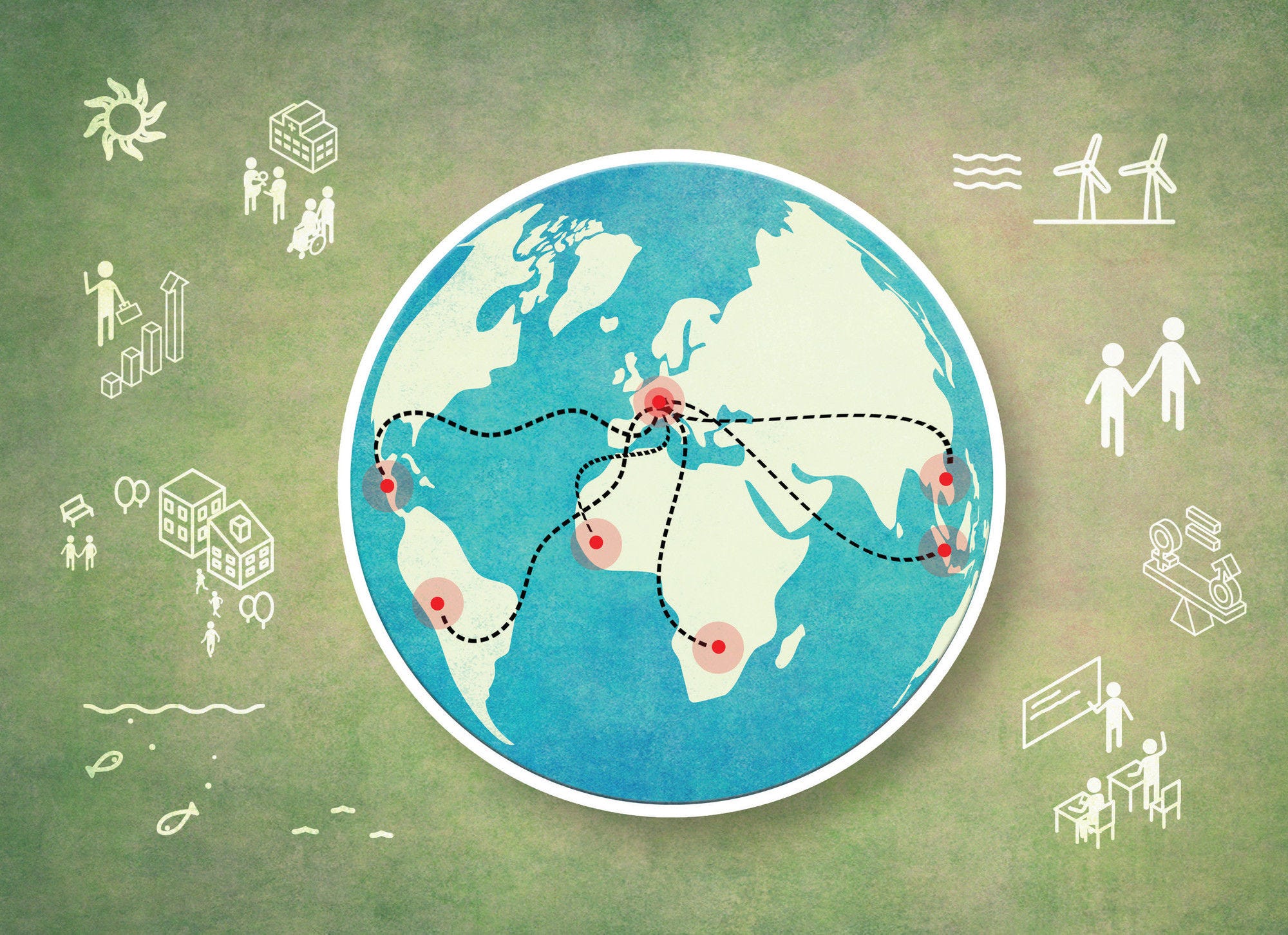City-to-city partnerships and decentralised development co-operation (DDC) can play a key role in advancing the SDGs and in addressing global megatrends, the aftermath of the COVID-19 pandemic and other shocks. This report discusses the framework conditions for effective city-to-city partnerships and takes stock of existing monitoring and evaluation mechanisms. As a complement, it proposes a systemic monitoring and evaluation framework for city-to-city partnerships to localise the SDGs, combining self-assessment and SDG indicators. This framework aims to bridge the gap in terms of measuring the progress of cities engaged in partnerships on the 2030 Agenda and their compliance with the G20 Rome High-Level Principles on city-to-city partnerships for localising the SDGs. The report also presents lessons learned from a pilot-testing of this new framework and highlights policy implications and ways forward to enhance the sustainability, transparency and accountability of city-to-city partnerships, in a shared responsibility across levels of government and stakeholders.
City-to-City Partnerships to Localise the Sustainable Development Goals

Abstract
Executive Summary
City-to-city partnerships and decentralised development co-operation (DDC) play a key role in advancing global agendas, preparing for global megatrends and adapting to a wide range of crises and shocks. The adoption of global agendas such as the Paris Climate Agreement, the 2030 Agenda and the G20 Rome High-Level Principles on city-to-city partnerships for localising the SDGs has emphasised the importance of cities and regions for sustainable development. For example, cities and regions can support each other through peer-to-peer learning and capacity building on key territorial development issues where they have the technical competency, such as education, health and water. This report discusses the framework conditions for effective city-to-city partnerships and takes stock of existing monitoring and evaluation (M&E) mechanisms. Finally, it proposes a systemic M&E framework for city-to-city partnerships to localise the SDGs, combining self-assessment and SDG indicators.
Key findings
City-to-city partnerships are a key vehicle of decentralised development co-operation
Between 2015 and 2021, the total volume of DDC activities, measured through official development assistance (ODA) data, increased by 38% from USD 2 051 million to USD 2 831 million. Germany (USD 1 901 million in 2021) and Spain (USD 389 million in 2021) were the top 2 ODA providers.
City-to-city partnerships, which are a modality of DDC, often go beyond financial flows and transfers and include in-kind contributions such as peer-to-peer learning and capacity building. Recently, they have evolved from bilateral twinning to more sophisticated and comprehensive modalities including multi-stakeholder partnerships with civil society, academia and the private sector.
The right enabling conditions can help city-to-city partnerships advance sustainable development
Several tools and checklists (e.g. the OECD Checklist for Public Action to localise the SDGs and the G20 Principles) define the relevant framework conditions for city-to-city partnerships. In particular, such guidelines call for a clear strategy for city-to-city partnerships, outlining their rationale and aim. To be effective and sustainable, city-to-city partnerships need an enabling multi-level governance structure, legal and institutional frameworks as well as local capacity and technical skills to advance the collaboration on joint policy priorities with partners in the Global South. Data collection and information sharing as well as stakeholder engagement are also crucial to promote transparency and ownership.
However, there is currently no framework to measure the extent to which cities engaged in city-to-city partnerships have such framework conditions in place and how much progress they are making towards achieving the SDGs.
There are however challenges to their effective implementation
Many city-to-city partnerships face challenges, which range from the lack of data and reporting, weak co-ordination across levels of government, actors and departments due to the lack of clarity regarding the competency for DDC between local, regional and national levels, the lack of accountability and transparency due to weak M&E through to insufficient local capacities, which affects project management, that can result in the delivery of predominantly small-scale projects, and in turn, missed opportunities to create economies of scale, and ultimately negatively impact their effectiveness.
More specifically, a critical challenge for city-to-city partnerships is the lack of a quantitative M&E component measuring the impact of partnerships on sustainable development outcomes. Even in the partnerships where M&E frameworks exist, they are primarily focused on assessing input results, whereas attention to outcomes and impact remains limited.
A new systemic M&E framework for city-to-city partnerships addresses the need for a complementary tool to assess the sustainability of partnerships
This report proposes a systemic M&E framework for city-to-city partnerships to localise the SDGs. It includes two components:
First, it offers a self-assessment tool with 57 questions, which is intended to be used during workshops with territorial stakeholders, to assess the state of play of relevant enabling conditions (e.g. place-based policies, data, peer-to-peer learning, stakeholder engagement, multi-level governance) and the extent to which city-to-city partnerships comply with each of the ten G20 Rome High-Level Principles. For each of the questions related to a specific Principle, stakeholders can rate the level of its implementation or achievement based on a rating system (ranging from 1 to 5).
Second, it proposes a set of 59 SDG indicators to measure the progress of the involved cities on the SDGs. The indicators cover all 17 SDGs, with a particular focus on “Sustainable Cities and Communities” (SDG 11) and “Partnerships for the Goals” (SDG 17). They were selected based an extensive mapping of existing SDG indicator frameworks to best fit the case of city-to-city partnerships.
By combining a self-assessment and a list of indicators, the M&E framework allows for analysing the sustainability of city-to-city partnerships both in terms of process (compliance with the G20 Principles) and outcomes (progress on the SDGs).
A pilot testing of the self-assessment framework with 27 city-to-city partnerships supported by the European Commission (EC) highlights that among the ten G20 Principles, partnerships show the best results on peer-to-peer learning (average self-assessment of 3.7 points on a scale from 1 to 5) and a territorial approach (3.44). By contrast, partnerships are lagging the most on financing (2.44), mainly due to difficulties in mobilising sufficient funding to shape their activities according to the needs of the local stakeholders and project partners and limited leeway to manage revenues.
Proposed ways forward
The report suggests ways forward to leverage the proposed M&E framework within their city-to-city partnerships in order to:
Improve transparency and accountability
Use the M&E framework to help improve the transparency of city-to-city partnerships, reduce information asymmetries and corruption risks and enhance accountability of the cities and stakeholders engaged in the collaboration. To that end, set up a mechanism to verify that stakeholders’ inputs were considered and make monitoring and evaluation results available to the general public, e.g. through the disclosure of quantitative and qualitative data on partnerships and their impacts in social media and dedicated web pages.
Develop evidence-based territorial policies to achieve the SDGs
Leverage the M&E framework to define local urban development needs and priorities and SDGs that can benefit the most from city-to-city partnerships.
Expand data collection on the partnerships to monitor cities’ progress towards achieving the SDGs and identify the framework conditions to advance sustainable development
Use the M&E framework to expand data collection efforts, for example via joint working groups with experts from statistical offices and other key actors to develop strategies on how to collect data on the outputs and outcomes of the partnerships.
Monitor progress towards achieving the SDGs through the 59 indicators. Use the results from the indicator framework to assess cities’ strengths and weaknesses to define future priorities of city-to-city partnerships to help address them.
Assess the coherence of city-to-city partnerships with the G20 Principles through the self-assessment framework. That analysis should help develop follow-up actions to advance the partnerships’ objectives and be repeated on a regular basis to track progress made over time.
Strengthen multi-level governance to foster sustainable development and engage stakeholders to create ownership around the M&E framework
Strengthen multi-level governance to achieve the SDGs through the M&E framework, e.g. by leveraging the self-assessment process to foster dialogue and communication across departments and with other levels of government to align sustainable development policies and partnerships. Engage territorial stakeholders in the M&E of the partnership to improve their ownership of the evaluation process, shift towards a demand-driven, need-oriented approach and increase social and political acceptance of the partnership.
Build capacity and facilitate peer-to-peer learning
Help territorial stakeholders build technical capacities, e.g. by exchanging with other actors involved in the partnership to acquire the necessary knowledge to collect evidence of the impact of the activities of the partnership. Furthermore, harness the self-assessment process to facilitate peer-to-peer learning with other partnerships to learn how they have overcome similar obstacles and challenges.










